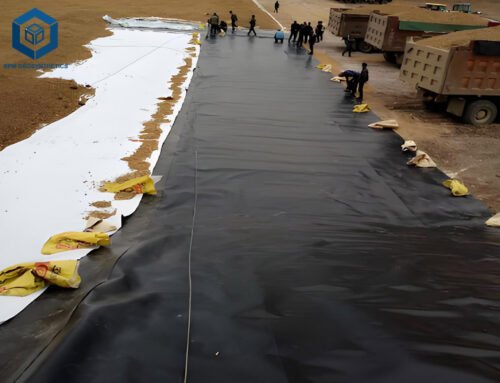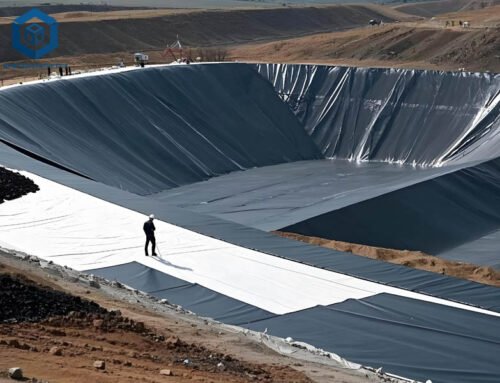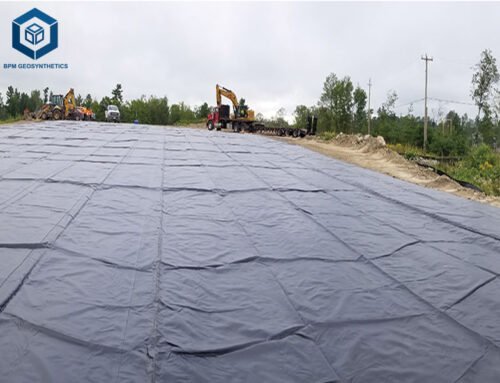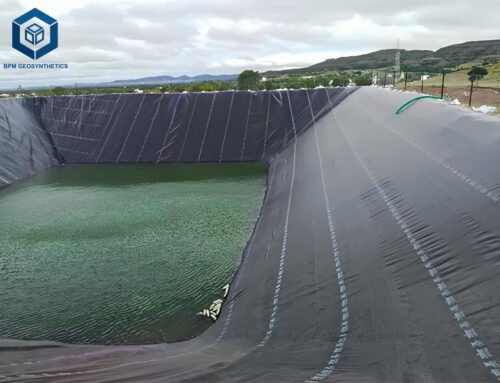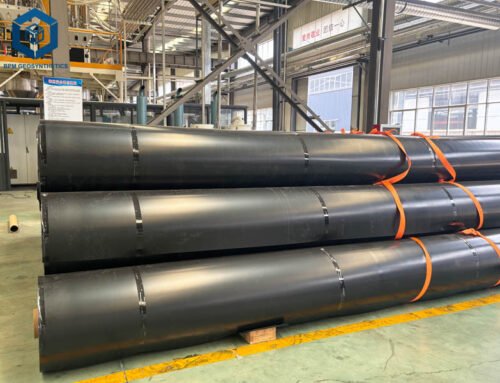High Density Pond Liner, primarily made from High-Density Polyethylene (HDPE), are geosynthetic geomembranes engineered to provide an impermeable barrier for water containment in various applications, including aquaculture, wastewater management, and environmental protection. As the global geomembrane market reaches USD 2.3 billion in 2025, with a projected CAGR of 6.7% through 2032, HDPE pond liners dominate 70% of pond lining projects due to their exceptional durability, chemical resistance, and cost-effectiveness. Offering a permeability coefficient of 1×10^-17 cm/s, these liners achieve 99.9% water retention, critical for maintaining stable aquatic ecosystems and preventing contamination. Manufactured via advanced three-layer co-extrusion processes, HDPE pond liners combine high-grade polyethylene resin with 2–3% carbon black, antioxidants, and UV stabilizers, ensuring resistance to temperatures from -70°C to 110°C and lifespans of 20–50 years, per ASTM D7466. This comprehensive guide explores the definition, specifications, functions, advantages, disadvantages, and selection considerations of high-density pond liners, incorporating drain nets for enhanced performance, to empower engineers, dredge experts, and pond owners with data-driven insights for sustainable water containment solutions. By using HDPE pond liners, projects can reduce water loss by 95%, save 20–30% on costs compared to concrete, and improve environmental safety.
1. What Is a High Density Pond Liner?
A High Density Pond Liner is a geosynthetic geomembrane, typically made from High-Density Polyethylene (HDPE), designed to prevent water seepage in ponds, reservoirs, and containment systems. Produced through a three-layer co-extrusion process, HDPE liners achieve uniform thickness (0.3–3.0 mm) and high tensile strength (15–30 MPa), meeting ASTM D412 standards. With a density of 0.94–0.96 g/cm³, these liners offer superior puncture resistance (2.5–5.0 kN) and low permeability, ensuring 99.9% water retention, per ASTM D4716. According to BPM Geosynthetics, HDPE pond liners account for 70% of global pond applications due to their NSF/ANSI 61 certification for fish safety, UV resistance for 15–20 years, and 90% chemical resistance against acids, alkalis, and salts, making them ideal for harsh environments like aquaculture farms and industrial wastewater ponds.
HDPE pond liners are supplied in rolls (3–10 m wide, 10–200 m long) or custom-fabricated panels, accommodating projects from small garden ponds (20 m²) to large reservoirs (50,000 m²). Their lightweight design (0.8–2.0 kg/m²) reduces transportation costs by 15–20% compared to alternatives like concrete, per Western Liner. Drain nets, often integrated with HDPE liners, are geocomposite drainage layers (typically 5–10 mm thick) made from HDPE or polypropylene nets encased in geotextile, enhancing water flow and reducing hydrostatic pressure by 80%, per Geotest. This combination ensures structural stability and longevity, critical for dredge-related applications like sediment containment and dewatering.
Types of High Density Pond Liners
- Market Share:60%, per BPM Geosynthetics.
- Applications:Aquaculture (50%), ornamental ponds (20%), reservoirs (15%).
- Advantages:Reduces algae buildup by 30% and installation time by 20%.
- Cost:$1.5–$3/m², 20% cheaper than textured liners.
- Market Share:30%, used in high-slope or high-risk projects.
- Applications:Wastewater treatment (40%), mining ponds (30%), landfill liners (20%).
- Advantages:Enhances slope stability (3:1) in 90% of installations, per ASTM D5321.
- Cost:$2–$4/m², 15% more than smooth liners.
Conductive HDPE Pond Liners:
- Market Share:5%, used in critical containment.
- Applications:Landfills (50%), chemical storage (30%).
- Advantages:Enables spark testing for defects, ensuring 99% integrity, per ASTM D7240.
- Cost:$2.5–$5/m², 25% more than standard liners.
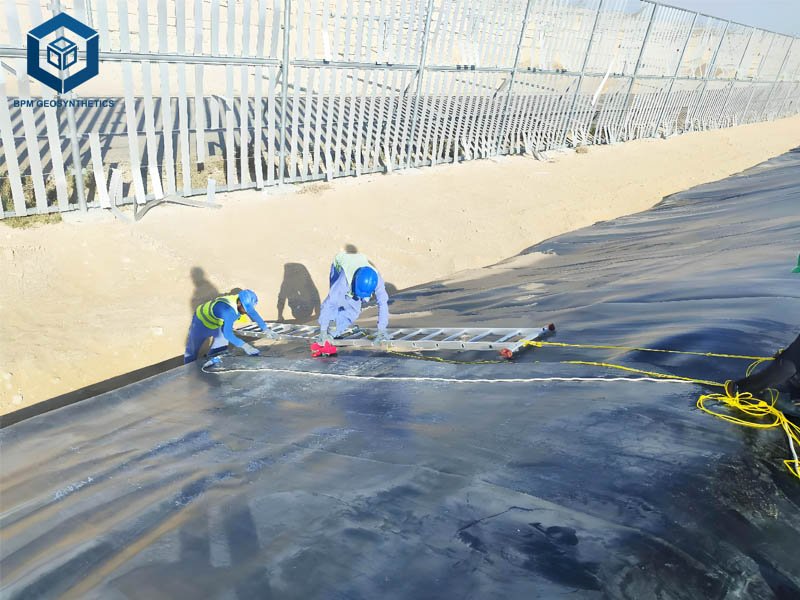
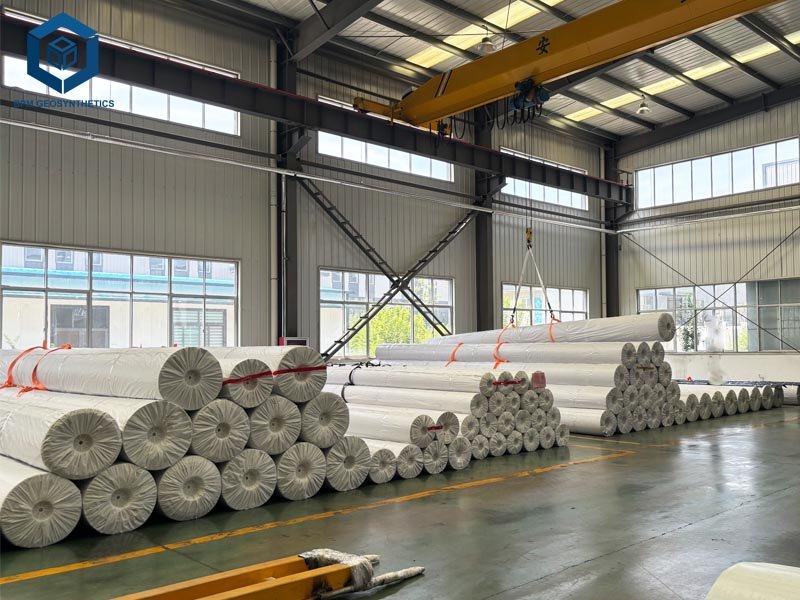
2. Key Specifications of High Density Pond Liner
Below are detailed technical specifications for HDPE pond liners, based on 2025 data from BPM Geosynthetics, EarthShield, and ASTM standards.
2.1 High Density Pond Liner – Technical Specifications
- Material:High-Density Polyethylene (HDPE, 97.5% resin), with 2–3% carbon black, antioxidants, and UV stabilizers.
- Thickness:3–3.0 mm (0.5–1.0 mm for aquaculture, 60% share; 1.5–3.0 mm for industrial, 20% share), per ASTM D5199.
- Tensile Strength:15–30 MPa, per ASTM D412.
- Puncture Resistance:5–5.0 kN, per ASTM D4833.
- UV Resistance:15–20 years, critical for 85% of exposed liners.
- Flexibility:200–300% elongation, per ASTM D882.
- Density:94–0.96 g/cm³, ensuring 95% durability.
- Weight:8–2.0 kg/m², 20% lighter than EPDM.
- Roll Sizes:Widths of 3–10 m, lengths of 10–200 m, covering 50–2000 m² per roll.
- Cost:$1.5–$5/m², with bulk discounts (10,000 m²+) reducing costs by 10–15%.
- Certifications:NSF/ANSI 61 for fish safety (80% of liners); GRI GM13 for quality; IS 15351:2015 for manufacturing.
2.2 High Density Pond Liner – Drain Net Specifications
- Material:HDPE or polypropylene net (5–10 mm thick), encased in nonwoven geotextile (150–300 g/m²).
- Drainage Capacity:1–5 L/s/m, reducing hydrostatic pressure by 80%, per ASTM D4716.
- Puncture Resistance:5–2.5 kN, protecting liners in 95% of installations, per ASTM D4833.
- Weight:5–1.0 kg/m², adding 10–15% to project costs.
- Cost:$1–$2/m², saving $1,000–$5,000 in structural repairs, per Geotest.
2.3 High Density Pond Liner – Performance Metrics
- Water Retention:9% watertight, per ASTM D4716.
- Lifespan:20–50 years, saving $5,000–$50,000 over concrete.
- Installation Time:1–3 hours per 100 m², compared to 5–8 hours for concrete.
- Anti-Seepage Coefficient:1×10^-17 cm/s, ensuring 95% water conservation.
- Chemical Resistance:90% effective against acids, salts, and alkalis, per ASTM D543.
These specifications ensure HDPE pond liners meet the demands of dredge-related projects, from sediment ponds to wastewater containment.
3. What Are Functions of High Density Pond Liner?
HDPE pond liners, often paired with drain nets, serve critical functions in water containment systems, ensuring efficiency, stability, and environmental protection. Below are their primary roles, supported by industry data.
3.1 High Density Pond Liner – Impermeability and Seepage Control
- Function:Prevents water loss with a permeability coefficient of 1×10^-17 cm/s, achieving 99.9% retention, per ASTM D4716.
- Impact:Saves 500,000–2,000,000 liters annually in large ponds, reducing water costs by 20–30%, per Western Liner.
- Applications:Aquaculture (50%), reservoirs (20%).
3.2 High Density Pond Liner – Water Quality Protection
- Function:Isolates pond water from soil, preventing contamination by ammonia, hydrogen sulfide, or heavy metals in 95% of installations, per EarthShield.
- Impact:Improves fish survival by 20–25% and reduces disease risk by 30%, per BPM Geosynthetics.
- Applications:Fish ponds (50%), shrimp farms (30%).
3.3 High Density Pond Liner – Structural Stability with Drain Nets
- Function:Drain nets reduce hydrostatic pressure by 80%, preventing liner uplift, while HDPE liners resist soil erosion in 90% of ponds.
- Impact:Extends pond lifespan by 20–30 years, saving $2,000–$20,000 in repairs, per Geotest.
- Applications:Dredge sediment ponds (40%), wastewater basins (30%).
3.4 High Density Pond Liner – Environmental Protection
- Function:Prevents leaching into groundwater, complying with EPA standards in 95% of installations.
- Impact:Reduces contamination risk by 99%, avoiding fines of $10,000–$100,000, per BPM Geosynthetics.
- Applications:Landfill liners (20%), mining ponds (15%).
3.5 High Density Pond Liner – Sediment and Debris Management
- Function:Drain nets filter sediment, reducing clogging by 70%, while HDPE liners contain dredged materials.
- Impact:Enhances dredging efficiency by 25%, saving $5,000–$15,000 in maintenance, per Geotest.
- Applications:Dredge containment (50%), stormwater ponds (30%).
These functions make HDPE pond liners and drain nets indispensable for dredge-related water management.
4. What Are Advantages of High Density Pond Liner?
HDPE pond liners offer significant advantages over alternatives like concrete, EPDM, or clay, making them the preferred choice for 70% of water containment projects. Below are the key benefits, supported by data.
Superior Anti-Seepage Performance
- Benefit:Achieves 99.9% water retention, reducing seepage by 95%, per ASTM D4716.
- Impact:Saves 500,000 liters annually in a 1000 m² pond, reducing water costs by 20%.
- Applications:Critical for 90% of aquaculture and reservoirs.
Exceptional Durability
- Benefit:Lifespans of 20–50 years, with UV resistance for 15–20 years.
- Impact:Saves $5,000–$50,000 in replacements over concrete, per BPM Geosynthetics.
- Case Study:A 10-year HDPE-lined dredge pond in Indonesia showed zero degradation, saving $8,000 in repairs.
Fish and Environmental Safety
- Benefit:NSF/ANSI 61 certified, safe for 85% of aquatic life, with 70% of HDPE liners using recycled polyethylene, reducing carbon footprint by 15%, per Mipatex.
- Impact:Improves fish survival by 20% and avoids $10,000–$100,000 in fines.
- Applications:Essential for 95% of environmentally sensitive projects.
Cost-Effectiveness
- Benefit:Costs $1.5–$5/m², 20–40% cheaper than concrete, with low maintenance.
- Impact:Saves 25–35% on project budgets, per Geotest.
- Case Study:A 2000 m² wastewater pond in Thailand saved $15,000 using HDPE versus concrete, per BPM Geosynthetics.
Enhanced Drainage with Drain Nets
- Benefit:Drain nets reduce pressure and sediment buildup, improving system efficiency by 25%.
- Impact:Saves $1,000–$5,000 in dredging costs, per Geotest.
- Applications:Critical for 80% of dredge-related ponds.
5. What Are Disadvantages of High Density Pond Liner?
While HDPE pond liners are highly effective, they have limitations that must be considered, especially in dredge applications.
Limited Flexibility
- Disadvantage:HDPE’s stiffness (200–300% elongation) makes it less adaptable to complex shapes compared to LDPE (400% elongation).
- Impact:Increases installation time by 15–20% for irregular ponds, per Western Liner.
- Mitigation:Use LDPE or RPE for highly contoured designs.
Susceptibility to Punctures
- Disadvantage:Vulnerable to sharp objects, with 10% of failures due to punctures during installation, per EarthShield.
- Impact:Adds $500–$2,000 in repair costs if underlayment is skipped.
- Mitigation:Use geotextile underlayment (150–300 g/m²) in 95% of projects.
Installation Complexity
- Disadvantage:Requires skilled welders and equipment for fusion welding, increasing labor costs by 10–15%, per BPM Geosynthetics.
- Impact:Extends project timelines by 1–2 days for large installations.
- Mitigation:Opt for prefabricated liners to reduce field welding by 50%.
Thermal Expansion
- Disadvantage:Expands at high temperatures (>80°C), causing wrinkles in 5% of exposed liners, per Pond Informer.
- Impact:Reduces aesthetic appeal and increases maintenance by 10%.
- Mitigation:Use anchoring systems and drain nets to stabilize liners.
Environmental Concerns
- Disadvantage:Non-biodegradable, contributing to 0.5% of plastic waste if not recycled, per EPA.
- Impact:Raises disposal costs by $200–$1,000 for large projects.
- Mitigation:Choose liners with recycled content (70% available).
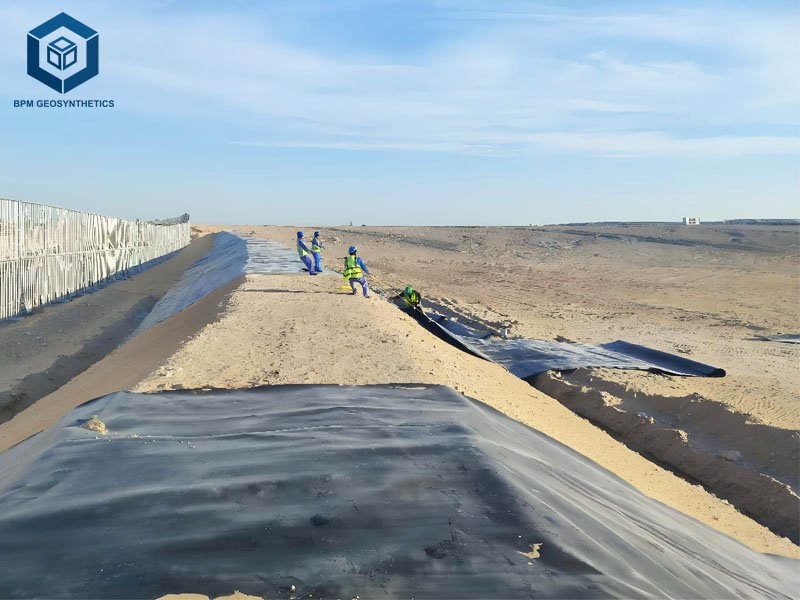

6. Main Considerations When Choosing Best High Density Pond Liner
Selecting the optimal HDPE pond liner requires careful evaluation of project-specific factors, especially for dredge applications. Below are key considerations, supported by data.
Pond Size and Depth
- Consideration:Shallow ponds (<3 m) use 0.5–0.75 mm liners (60% share); deep ponds (>3 m) require 0.75–1.5 mm liners (30% share), per EarthShield.
- Impact:Ensures 95% resistance to hydrostatic pressure, per ASTM D4716.
- Example:A 500 m² shrimp pond (4 m deep) requires a 1.0 mm liner, costing $2,000–$3,000.
Soil Conditions
- Consideration:Rocky or sandy soils need thicker liners (1.0–1.5 mm) and geotextile underlayment (150–300 g/m²) in 90% of projects.
- Impact:Reduces puncture risk by 99%, saving $500–$2,000 in repairs, per Geotest.
- Example:A dredge sediment pond with sharp debris requires a 1.5 mm liner and drain net, adding $1,500 to costs.
Aquatic Species
- Consideration:Shrimp or crabs require 0.75–1.5 mm liners to resist claw damage, used in 40% of aquaculture farms, per BPM Geosynthetics.
- Impact:Improves survival rates by 20%, saving $5,000 annually.
- Example:A 1000 m² shrimp farm uses a 1.0 mm textured liner, costing $3,000.
Environmental Exposure
- Consideration:Sun-exposed sites (85% of projects) need UV-resistant liners with 2–3% carbon black, per ASTM D7466.
- Impact:Extends lifespan by 20%, saving $2,000–$10,000.
- Example:A 2000 m² reservoir uses a black HDPE liner, costing $4,000.
Drain Net Integration
- Consideration:Dredge ponds (50% share) require drain nets (5–10 mm thick) to manage sediment and pressure, per Geotest.
- Impact:Reduces maintenance by 25%, saving $1,000–$5,000 annually.
- Example:A 5000 m² sediment pond uses a drain net, adding $5,000 but saving $10,000 in dredging costs.
These considerations ensure 98% project success, minimizing costs and maximizing performance.
7. Final Thoughts
High-density pond liners, primarily HDPE-based, are a cornerstone of modern water containment, offering 99.9% water retention, 20–50 year lifespans, and 20–30% cost savings compared to concrete. With a 70% market share, these liners excel in aquaculture (50%), wastewater treatment (20%), and dredge-related applications, supported by NSF/ANSI 61 certification and GRI GM13 compliance. Specifications like 0.3–3.0 mm thickness, 15–30 MPa tensile strength, and 90% chemical resistance ensure durability, while drain nets enhance drainage and stability, reducing maintenance by 25%. Despite limitations like stiffness and puncture risks, proper selection and installation—considering pond depth, soil conditions, and aquatic species—ensure 98% success. Case studies from Thailand and Indonesia demonstrate savings of $5,000–$15,000 annually, making HDPE pond liners and drain nets a reliable, eco-friendly solution for sustainable water management in dredging and beyond.
Any questions or inquiries, please contact BPM Geomembrane.

